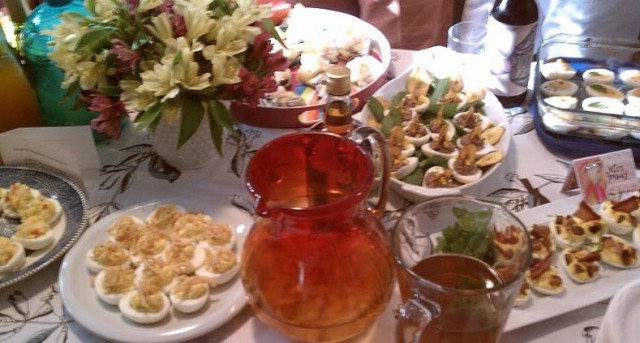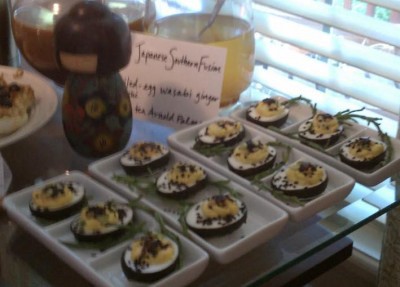The Ultimate, Fabulous Guide to Deviled Eggs
by Emerson Beyer

From left to right: Miss Grandma’s Backyard (Potato Salad Egg with Apricot Fizz); Mademoiselle Alsace-Lorraine (Creamy, Lemony Egg with Reisling-Plum-Rosemary Punch); Miss Soul Custardy (Vanilla Custard and Chocolate Egg in Phyllo with Peach-Cayenne Coffee Frappe); Senorita El Trionfo de la Revolucion (Chicken Liver and Havana Club Egg served with Barbadian Rum); Miss Piggie (Egg with Jowl, Side and Belly Bacon served with Mint Julep); Jury Award Winner: Miss Spicy German (Red Curry, Sweet Chili, and Spicy Chili Eggs with Home Brewed Double Wheat Ale).
There’s no activity that can’t be improved with a little competition. Down South, where I live, sporting activities are eschewed all summer. Instead we channel our competitive impulses into more genteel, less sweaty pursuits, sometimes involving fabulous straw hats!
Each summer before the mosquitos start to flourish, my husband and I host a garden party and Deviled Egg Pageant. The entrants, though not all Southern, exemplify the seersucker-shrouded bloodlust that makes summer in the South both delicious and dramatic.
As long as the weather and space permit, a Deviled Egg Pageant allows you to entertain dozens of friends and neighbors while preparing little more than a plate of ham, perhaps, and a pound cake. Your kitchen remains cool and spotless while the guests enthusiastically do the hard work.
The keys to a successful pageant are clear rules and a dress code to set the tone. (Here is a Google Doc of our house rules; take what you like and leave the rest.)
If you don’t have the space or inclination to host such a contest, preparing pageant-worthy deviled eggs is a sure way to “win” whatever parties or picnics you may attend in the summer. Here are some lessons from our pageant kings and queens.
The Egg Came First
No matter what kind of nuanced flavor profile or teetering tower of garnish you plan to construct, a good deviled egg begins with a well cooked chicken egg.
Oh, you were thinking of a goose, duck or quail egg? I can’t stop you, though I’d like to try. The chicken egg is just the right size for deviling. It is a satisfying snack for one but just big enough to share.
For deviling, you want the egg white rather firm, but not chewy. It must immediately please the palate and provide a sound textural platform for the entire recipe. The yolk should be very fully cooked, even dry, since you’ll be emulsifying it in some other fats. “Hard boiled” is misleading; it would be best if you didn’t let the egg “boil” at all.
You probably have Harold McGee’s helpful volume on your cookbook shelf. If so, turn to “Hard Cooked Eggs.” I can offer no better advice than his, but I can summarize: Use week-old eggs, having stored them on their sides to ensure symmetry. Fill the pot all the way up. Start the eggs in cool water. Bring the water to 190F, and hold it there for 15 minutes. Then immediately transfer the eggs to a bowl of ice water.
Note: You must watch the pot and/or thermometer in order to ensure you don’t overcook. With a full pot, this is interminable. Pass the time by listening to The Splendid Table.
Filling and Flavoring
The deviled egg filling that we have come to consider traditional is egg yolks mashed with (store-bought) mayonnaise. This is justifiably popular because it is delicious. In fact, the filling is itself a sort of mayonnaise — the yolk pulverized or beaten then suspended in whipped oil. Hmm, that should sound tasty, but it doesn’t! If using jarred mayonnaise, be aware that the egginess may be amplified. If that is distasteful to you, consider a vegan mayonnaise that will showcase the more delicate flavors of your gently hard-cooked yolk, rather than what to you tastes like a sulfurous, vinegary gloop.
Don’t feel bound to a recipe — you’ll get the ratios right through titration. Start by mashing 5/6 or 10/12 of your yolks thoroughly by hand. Do not put them in a food processor as this will certainly lead to runny filling. A wire dough blender is a great tool for this. Add your mayonnaise a bit at a time. Your reserved egg yolks are there so you can correct your work if necessary.
There are alternatives to mayonnaise, and you should experiment with them. Heavy cream, sour cream and creme fraiche are all options — make sure you use them near room temperature, and thicken them a bit by beating briefly with a whisk to incorporate air. A runny filling dishonors your galant egg white.

Our Audience Award Winner: Miss Japanese Southern Fusion.
Ginger-Wasabi-Black Sesame Eggs served Nigiri Style with Nori paired with Green Tea Arnold Palmer.
Advanced Techniques
Mustard is popularly used as a deviled egg flavoring. What a shame! Such a custom is likely to originate from the desire to brighten the yellow color of the filling. But, mustard also amplifies the pungency of acetic or citric acid the mayonnaise, rather than contributing complimentary flavors.
Minced fines herbes or homemade “green mayonnaise” with pounded basil, chive, dill, tarragon or watercress is a lovely way to add both craft and flavor to the egg at this stage, but the resulting greenish paste will demand cosmetic intervention when served. Please, please resist the urge to do a Dr. Seuss thing.
The most popular flavorings among our pageant entrants have been sriracha and curry. Wasabi always makes an appearance, as do jalapenos. Bold spices certainly partner well with egg, as any chilaquiles-lover knows. Steer clear of garlic, though — that’s an exception.
Are you fancy? Parlez-vous francais? Then perhaps you would like to fill your egg whites with a savory sabayon or mousse! I’m not going to get into that right now, but you should definitely consider it, and maybe we’ll talk later.
Have you ever considered a sweet deviled egg? Of course you should — egg is the unctuous heart of so many desserts. Replace mayonnaise with whipped, sweetened Neufchatel or chevre, flavor with vanilla, and garnish with a cinnamon crouton or crumbled graham crackers.
Adding Texture, Inside and Out
Even if the egg is cooked perfectly, with a firm yet delicate white, and an airy yet rich filling, the deviled egg is unfortunately rather soft and homogenous. Thoughtful non-egg additions can add textural and visual interest. They encourage bites and chewing rather than the slithery swallow of a too-fat oyster.
Bacon or other cured meats work naturally, especially along with herbs like chervil and chive. Finely diced potato, onion or apple, slowly poached or confited, can be incorporated. Beet chips, commercially fried or baked at home, are wonderful on top of a curry-flavored filling. One of our pageant’s perennial superstars this year entered a deviled egg with a cream-based, zest-brightened filling topped with good ol’ French Fried Onions, merging haute technique and common groceries into an elegant Alsatian delight.
The Right Drink
If you’re tired of reading, feel free to stop after I say: Iced Tea. Or stick with me: make it strong and very sweet. Mix it with lemonade, vodka or both. Alongside a wasabi-and-sesame deviled egg (wrapped in nori, nigiri-style, as one of this year’s pageant stars did), make a Green Tea Arnold Palmer.
Because of eggs’ traditional home on the breakfast plate, and because wine pairs just adequately (not delightfully) with eggs, breakfast offers many inspirations. How about maple-infused iced coffee spiked with bourbon and served with that guanciale-studded egg? Instead of coffee, maybe juice — perhaps a Greyhound? Wouldn’t that be nice alongside a chorizo-and-saffron egg instead of Sangria?
Punches and cups are festive and offer chances to involve more flavors to complement more complicated egg recipes. Pimms No. 1 Cup practically flooded last year’s pageant. The Alsatian beauty mentioned above came with a Riesling-Rosemary-Plum Punch. Seriously, I have such amazing friends! A shandy is great with spicy or seafood-topped eggs. Juleps are perfect if you’re feeling deliriously Southern, though a punch made of dry white wine, sherry, watercress and tonic water is more subtle and will allow you to enjoy the party longer.
Finally, don’t forget to bring your own platter or a footed plate. Those dimpled platters are terrific because they prevent the eggs from sliding around, but a bed of shredded lettuce or carrots will work fine.
K. Emerson Beyer, environmentalist and gadabout, lives with his husband, dog and cat in Durham, N.C. All four of them share Asperger’s-level concern with food, though only two of them bother helping out in the kitchen. Emerson half-heartedly retweets miscellany as @patebrisee.
